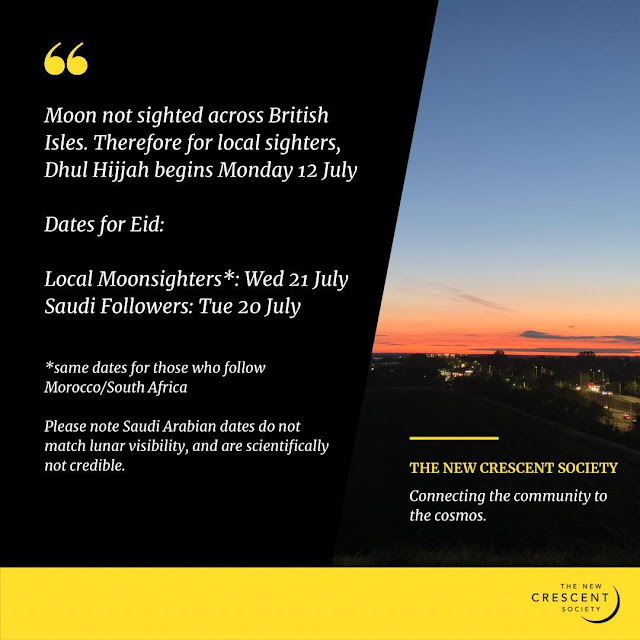Saudi Arabia Moonsightig for Dhul Hijjah 2021 / 1442: Are Saudi Looking on the Wrong Date?
Imad Ahmed
Thursday 8 July 2021
27 Dhul Qaidah 1442
A GLITCH IN THE SAUDI MOONSIGHTING SYSTEM?
Saudi Arabia have instructed their moonsighters to search for the moon in the horizons on Friday 9 July, tomorrow, which is undeniably scientifically the WRONG date, and a date too early. You can read about this in their press release, here, in English, and here, in Arabic.
"Riyadh, July 07, 2021, SPA -- The Supreme Court has called on all Muslims throughout the Kingdom of Saudi Arabia to sight the crescent of the month of Dhu Al-Hijjah on Friday Evening, Dhu-AlQa'dah 29, 1442 AH, corresponding to 9 July 2021."
This is a day too early, scientifically!
WHY DID THEY START A DAY TOO EARLY?
This is one of the problems of having a MIXED calendar system, which switches between the fixed Umm al Qura calendar 8 months of a year, to moonsigthing 4 months of a year.
Saudi Arabia started the month a day too early, as they began it according to the Umm al Qura calendar, which does not correspond to the moon. Now they are switching to moonsighting this month, it has caused them to look a day too early.
Please watch our video which explains the Saudi Mixed Calendar system, and why these glitches happen every year: https://www.youtube.com/watch?v=2I1VH-nDmTc
THE SCIENTIFIC PROOFS THAT SAUDI ARE LOOKING ON THE WRONG DATE
1) An Islamic calendar month cannot scientifically begin on the same day of the eclipse.
Saudi actually started this current month on the evening of Thursday 10 June, the day of the solar eclipse.
This is because, on the day of the eclipse, you can visually see that the moon and sun are TOGETHER, whereas the Islamic calendar month begins when the sun and moon are APART, and so a crescent can be formed. This normally happens a day or two AFTER an eclipse.
This is what the solar eclipse looked like on Thursday 10 June 2021:
 |
| Solar eclipses and New Crescents do not happen on the same day |
This is what a New Crescent Moon looks like:
They represent totally different phases of the moon, and cannot occur on the same day!
By starting on the day of the eclipse, they have started a day too early - which explains why they are looking for the moon a day too early. Again, watch our video posted above for a fuller explanation!
2) The moon will be BELOW the horizon and BEFORE conjunction on the day they're looking.
This is another demonstration that their moonsighting is way too early and their sighting is not in harmony with the phases of the moon.
If their moonsighting was correct, and their calendar in line with the lunar phases, you would never be looking for the moon BEFORE conjunction!
WHAT DOES THIS MEAN FOR US IN THE UK?
This spectacular mistake is nothing new.
It may well be a cause of divided Eid dates for us in the UK this year again. Many mosques will follow Saudi Arabia, irrespective of the scientific validity of their moonsighting, and may do Eid on a different day to other mosques.
UPDATE: Saudi said that they did not see the moon (obviously), so they will complet 30 days for Dhul Qaidah. Total error!! They will begin Dhul Hijjah scientifically before the moon is impossible, and this will cause a SPLIT EID DATE in the UK.
Locally, moonsighters will go out on the (scientifically correct) date of Saturday 10 July. We'll livestream this and show you how it goes!!
PS: This has happened before, for Ramadan, and Saudi admitted their mistake and glitches in their calendar. You can read our blog on it here.
And make sure to watch the explainer video which explains the Saudi calendar here! https://www.youtube.com/watch?v=2I1VH-nDmTc




Everything change in Saudi, even Turkey, Egypt and Malaysia accept moon conjunction instead of Sighting. Accept India, Pakistan and Bangladesh the whole world follows now moon conjunction and great conspiracy going on.. but indo-pak atlast will remain stick to Hadees..Saudi keeps blundering Haj and Ramadan by luring Ummah to watch crescent even before conjunction. How treacherous..pity to Ummah
ReplyDeleteExcept
ReplyDeleteInstead of Accept above